This post may contain affiliate links. If you click through a link and make a purchase, I may receive a commission at no additional cost to you. As an Amazon Associate, I earn from qualifying purchases. Read the full disclosure here.
Do you have an annoying case of tennis elbow that isn’t getting better?
Tennis elbow is the most common overuse injury of the elbow, and many are surprised to learn that you don’t have to play tennis to have this annoying injury cramp your style.
Treating tennis elbow can be tricky. Exactly how long does tennis elbow last?
That depends on quite a few factors that we’ll get deep into in this article.
By the end, you’ll have a better understanding of what tennis elbow is, what to focus on moving forward, and a boatload of tips for how to prevent tennis elbow pain from creeping back into your life!
Let’s get started!
- What is tennis elbow?
- How long does tennis elbow last?
- Where is tennis elbow located?
- Symptoms of tennis elbow
- Quick relief for tennis elbow
- Surprising reasons why your tennis elbow isn’t getting better
- How to get rid of tennis elbow
- Do tennis elbow braces work?
- Kinesiology taping for tennis elbow
- Can exercising prevent tennis elbow?
Disclaimer: This content is for educational purposes and is not medical advice. Read the full disclaimer.
What is tennis elbow?
Tennis elbow is the general term for lateral epicondylitis, the most common overuse syndrome of the elbow.
With overuse, inflammation and micro-tears can occur in the tendon of the wrist extensors, which run along the forearm and attach to the bone just above the lateral elbow. Scar tissue may build up over time with chronic inflammation.
I don’t play tennis, so what gives?
Unfortunately, you don’t need to play a racquet sport to be plagued by this type of elbow injury.
What causes tennis elbow?
- Repetitive movement using forearm muscles such as typing, working with tools, knitting, gardening, and gripping
- Working in awkward positions
- Excessive overhead reaching or overhead work
- Sports and other forceful exertional activities, especially with poor form
How long does tennis elbow last?
Generally, tennis elbow can last anywhere from a few weeks to a few years. (Yikes!)
I know that sounds like a ridiculous range, but it depends on several factors, including how long you’ve had the pain, daily activities, as well as other medical conditions.
The earlier you can get your symptoms addressed, the faster you can recover. Once a musculoskeletal condition becomes chronic, it takes longer to heal the tissue and undo any other compensations affecting nearby joints.
Where is tennis elbow located?
Let’s back up and start at the beginning to give you the full picture on why tennis elbow is tricky to heal.
Because who thinks about the elbow unless there’s a problem?
The elbow complex consists of the radiohumeral and radioulnar joints and the proximal and distal radioulnar joints. Or, in other words, a bunch of uniquely shaped curvy joints that fit together just right.
These uniquely shaped bones allow elbow flex and extend, and they also turn the forearm (supination and pronation).
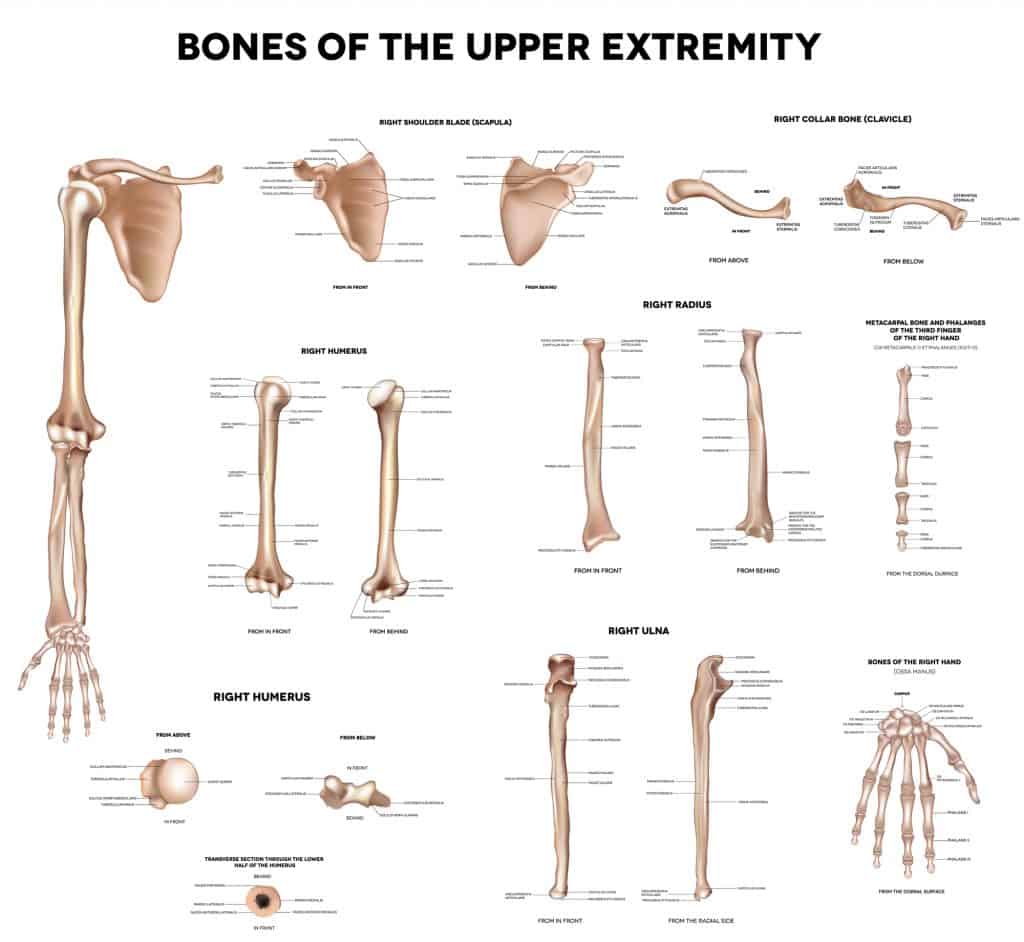
The extensor tendons of the forearm (connected to muscles that extend the wrist) attach above the elbow joint at the lateral epicondyle of the humerus (the outside of the elbow).
Extensor carpi radialis brevis (ECRB – a wrist extensor tendon) is the main culprit for tennis elbow but may include other wrist extensor muscles as well.
Because there’s always some confusion, here’s a quick rundown of muscles and tendons.
Muscles are made of soft tissue, arranged in fibers, that contract (shorten) and relax (lengthen) to produce movements.
Tendons connect muscle to bone. Tendons have receptors that communicate with the brain and spinal cord to relay information and tell the muscle to contract or relax.
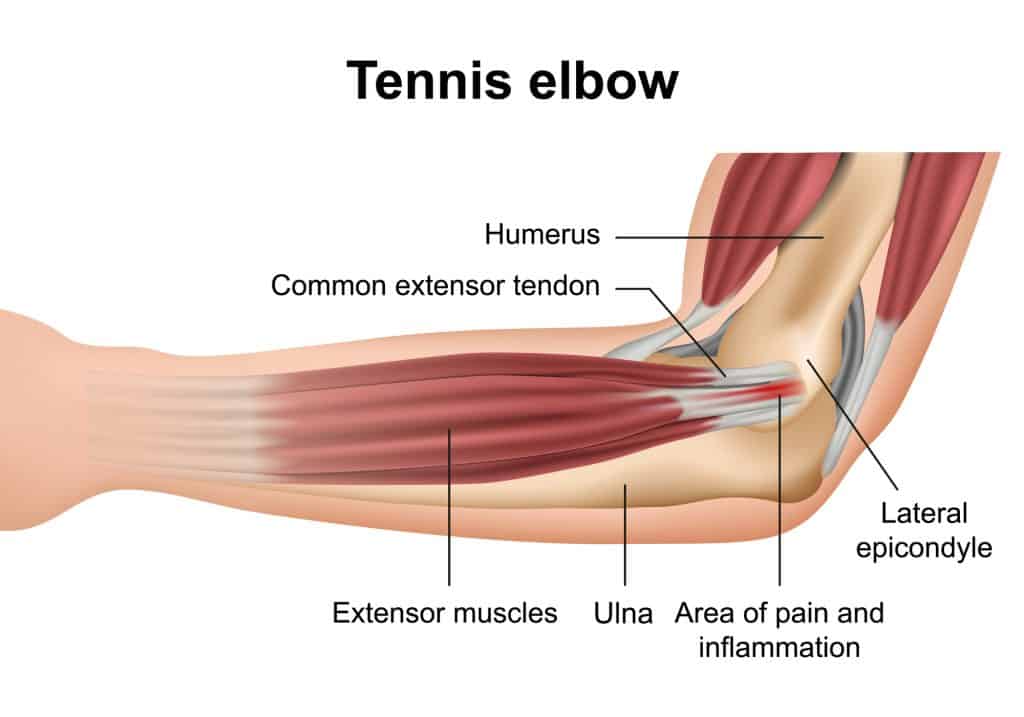
With overuse, micro-tears can occur in the tendon.
Flexion and extension of the elbow can also irritate this already inflamed tendon as it rubs against the bone. Ouch.
How is tennis elbow different than golfer’s elbow?
Tennis elbow occurs on the lateral side (outside) of the elbow (lateral epicondylitis) and involves the wrist extensors. Golfer’s elbow occurs on the medial side (inside) of the elbow (medial epicondylitis) and involves the wrist flexors.
They’re similar in that they are both tendonitis and occur from overuse, but the location differs.
Symptoms of tennis elbow
- Lateral elbow pain (often described as a dull ache) or tenderness along the tendon, located just outside of the elbow joint
- Pain that gets worse with movement especially of the wrist and elbow.
- Loss of range of motion
- Some report a crackling, gritty-like sensation with movement
- Mild swelling
- Weakness, decreased grip strength, and decreased overall function
Quick relief for tennis elbow
Here are some basic first-line treatments that people turn to at home to treat tennis elbow.
- Tennis elbow brace
- Ice packs
- Biofreeze pain relieving gel
- Anti-inflammatory medication
- Kinesiology taping
- Activity modification
These treatments are not wrong and may help to provide some temporary pain relief; however, they are all relatively passive, so the pain will likely still be there when you start moving again. Permanent relief will take longer and require more effort.
It’s important to look at other factors that may contribute to why you got tennis elbow in the first place that will continue to cause pain unless you address them.
Keep reading for some expert insight on how tennis elbow can rear its ugly head (and what you can do to stop it!)
Surprising reasons why your tennis elbow isn’t getting better
Tendonitis anywhere in the body is most commonly caused by overuse and repetitive stress by repeatedly performing the same or similar movements.
Tendonitis can also be caused by overloading when heavy loads are placed on a tendon too quickly, such as in weightlifting or other explosive sports activities.
If you’re constantly stressing an irritated area, it’s impossible for the damaged tissue to heal. It’s essential to identify things you might be doing during the day that are working against you.
Next, we’ll look at some not-so-obvious ways to develop tennis elbow and what not to do with tennis elbow.
Punching in cardio kickboxing
I’ve even seen people develop tennis elbow from “punching” in a cardio kickboxing class.
A punch involves the entire arm with a heavy emphasis on the shoulder and upper back muscles, and in casual cardio classes, most people are doing it wrong.
If you’re just standing there flailing your arms back and forth from the elbow and allowing your wrists to flop around, don’t be surprised if you start having tennis elbow symptoms.
This risk increases tremendously if your punching incorrectly while holding weights.
Don’t worry there’s an easy fix! Just talk to the instructor about proper form.
Holding weights while walking
Holding weights while walking can also encourage tendonitis.
This places a constant demand on the muscles and tendons at the elbow and probably isn’t worth the risk.
Hyperextending the elbow while weight-bearing on the arms
An example of this is during plank, side plank, or downward dog. Hyperextension is movement beyond the normal range of motion into extension and is common in people who are considered very flexible or “double-jointed.”
When you hyperextend the elbows, you’re no longer balancing the load properly through the joint. This can also signal your triceps to “turn off.” The triceps are a large muscle group and you can’t afford to have them not working.
Not only are you putting additional stress on the ligaments and joint capsule of the elbow, but the forearm muscles that cross the elbow (like the wrist extensors) have to work harder to stabilize your arm.
These smaller muscles can quickly become overworked because this job is more than they were designed to do and can result in tennis elbow.
Try to keep a mirco-bend in the elbow to avoid injury.
What causes tennis elbow?
If your tennis elbow isn’t getting better, it’s time to take a look at other things that can be stressing this area that may seem innocent.
- Repetitive gripping or lifting
- Repetitive motion using forearm muscles such as typing, working with tools, knitting, gardening, and gripping
- Poor wrist alignment and allowing the wrist to “break” while lifting weights.
- Poor elbow alignment
- Hyperextension of the elbows with weight-bearing through straight arms such as in plank or downward-facing dog.
- Not engaging larger muscle groups like shoulder and back in strength training or cardio movements like cardio kickboxing
- Not varying workout routines
- Being a “weekend warrior”
- Performing fitness movements with poor form
- Pushing too far when fatigued
- Ignoring pain
- Lifting too heavy
- Improper warm-up
Be sure and read What Makes Tennis Elbow Worse for a more detailed look into these seemingly innocent activities.
How to get rid of tennis elbow
In the case of tendonitis, complete prolonged tendon rest is often not useful. It’s a delicate balance between activity modification and avoiding painful movements when dealing with an injured tendon.
Try to identify repetitive movements that are causing pain. Stop or modify these activities by taking breaks or substituting them with other activities.
Avoid pushing through the pain, as this only feeds the inflammatory cycle and leads to further tissue damage.
Activity modification is an integral part of the healing process; however, too much rest can also be problematic. Gentle, pain-free range of motion exercises several times per day can help avoid secondary problems. Rest alone does not cure tendonitis.
Ignoring pain can lead to less use of the entire arm, leading to additional issues like shoulder tendonitis on top of the initial injury from lack of regular use, or holding your arm in awkward protective positions.
Ice can be helpful in the acute stages of injury.
Also, don’t forget that injuries, pain, and healing don’t just revolve around one isolated body part, they’re integrated into a larger system. Pain is greatly tied in with the nervous system, rather than originating from a single body tissue. Other factors such as general health, stress/anxiety, and overall regulation of the nervous system play a role in your elbow pain.
Get physical therapy
Conservative treatment for tennis elbow can be very successful.
Remember, tendonitis is one of the most common overuse injuries. Overuse can also come from imbalances in other areas of the body not pulling their fair share.
A physical therapist can help address other areas that may be contributing to the pain and give you a specific plan that’s tailored to you.
Make sure you check out:
- What Is Physical Therapy & How Can It Help You
- How To Prepare for Your First Physical Therapy Appointment
Exercises for tennis elbow
Studies have shown that eccentric exercises are beneficial to healing tendonitis. Tendons need to be loaded properly to function normally again.
Eccentric strengthening is loading a muscle while it’s lengthening, placing tension on the collagen fibers of the tendon to provide stress for remodeling of the tissue.
Using the biceps as an example, controlling the lowering of your hand (or weight) from your shoulder would be an eccentric contraction of the biceps.
Eccentric training can help improve functional strength, which mimics the demands of real-life activities.
To learn more about the different types of muscle strengthening, read Concentric, Eccentric, and Isometric Muscle Contractions – What’s the Difference?
Eccentrics can be done with:
Here’s a video demonstrating eccentric tennis elbow exercises.
Maintain good range of motion
It’s easy to think, “my elbow hurts, so I’ll stop using it.” In the case of tendonitis, it may appear as the pain decreases with rest, but then quickly returns with your arm’s use.
Not using muscles, joints, and tissues can cause further problems, including shoulder pain and neck pain.
Movement also helps circulation to bring healthy nutrients and flush away waste.
Check out the elbow & wrist flexibility library for stretching ideas.
See your doctor
Your best course of treatment will include a comprehensive approach.
An orthopedic surgeon that specializes in the upper extremity can be a good specialist to include in your care, especially if you’re not having luck with conservative treatments.
Don’t let the word surgeon scare you. There are plenty of less invasive treatments before pursuing tennis elbow surgery.
Your doctor may recommend anti-inflammatory medication or a corticosteroid injection.
Keep in mind that steroid injections are only one piece of the puzzle. It’s also essential to consider other components (such as muscle weakness or overuse) that lead to the development of tennis elbow in the first place. Otherwise, your pain will be waiting for you once the injection wears off.
Do tennis elbow braces work?
It depends. Let’s explore.
When looking for pain relief, it’s common to try anything. But it’s also important to know what works and what doesn’t so you don’t waste your time.
Some types of braces for tennis elbow can help if used appropriately. They should not be worn all the time and should be used in conjunction with activity modification and other treatments.
Braces do not magically fix a problem and, in some cases, can make an existing problem worse.
Let’s take a look at some of the common types of tennis elbow braces.
Compression sleeve
A regular elastic compression sleeve is unlikely to help tennis elbow.
Counterforce brace
Counterforce braces are another type of brace that may be useful for tennis elbow.

A counterforce brace looks like an adjustable strap with a small pressure point inside.
The pressure point area is meant to apply additional pressure over the tendon on the outer elbow to decrease tugging at the attachment site. In other words, to counter the force.
Wrist splints
Wrist splints are also sometimes used in tennis elbow treatment.
Since tennis elbow is an issue with the wrist extensors, limiting wrist motion is thought to help rest this area.
While a wrist splint may help with acute pain and inflammation, prolonged use of wrist immobilizers can also cause problems, especially if you continue to perform aggravating activities such as typing.
Now the muscles are asked to do the same job in a fixed position instead of allowing joints to move naturally.
Too much brace use can lead to tightness and overuse of forearm muscles since they are locked in one position, and the wrist cannot move through its full range of motion.
What does the research say about tennis elbow braces?
Kroslak M & Murrell G found that clinical studies demonstrated mixed results. Their review found some studies showing a benefit of bracing, while others showed no difference.
Sadeghi-Demneh E & Jafarian F found that counter-force braces were the most effective in decreasing pain compared to other types of braces.
Counterforce braces may help reduce pain. However, it’s essential to address the issue and not cover it up with a band-aid (i.e. long-term brace use), hoping the problem will go away.
In general, you should avoid wearing braces all the time (unless you’ve been specifically instructed to do so).
Braces often lead to a false sense of security, tricking you into continuing with the same habits that got you tennis elbow in the first place.
Kinesiology taping for tennis elbow
Taping is still a hot topic, eliciting a lot of interest when your favorite pro athlete emerges sporting artistically placed colorful tape.
Kinesiology taping is an elastic tape applied to the skin for a therapeutic benefit.
Some reasons for using kinesiology tape are:
- To support a weak area
- Improve proprioceptive input
- Re-educate muscles for healthy movement patterns
- Scar management
- Improve circulation
Giray E et al. found that kinesiology taping for tennis elbow with exercises was more effective than sham taping and exercises for improving pain and function due to tennis elbow.
Studies show that kinesiology taping is most effective when combined with other treatments.
I’m certified in the Kinesio Taping Method and have used taping techniques for many years. From my experience, it varies from person to person. It has been helpful in some cases as an adjunct to other treatments. However, not everyone is a good candidate for taping. Check out Kinesio Tape here.
Again, taping is not a magical (colorful) bandaid.
Related read: What Does Kinesiology Tape Do?
Can exercising prevent tennis elbow?
Unfortunately, there isn’t a set of exercises you can do that will prevent tennis elbow, it’s more about your overall form and movement patterns with activities coupled with taking breaks to avoid overuse.
Nothing is 100% preventable, but here are some general tips for tennis elbow injury prevention (and any type of tendonitis).
- Maintaining a good balance of muscle strength and flexibility throughout the body.
- Regularly moving joints and soft tissues through their full range of motion
- Promoting healthy movement patterns
- Increasing blood flow and load on tissues
- Performing a proper warm-up that includes dynamic mobility
Related:
Key takeaways
To properly heal tennis elbow, muscles and tendons need to be strengthened and loaded appropriately to tolerate everyday movement.
Rest alone does not cure tendonitis. It may feel better in the short term, but the pain will be right there to greet you when returning to activity.
Tennis elbow can be painful and frustrating. If your tennis elbow is not going away, ensure you get it checked out sooner than later to avoid chronic pain and get a treatment program specific to your needs.
Use these tips to evaluate your exercise program and see where you can make some positive changes to prevent tennis elbow in the future.
Related Articles:
- Keys to Maintain Healthy Shoulders
- Shake Off Text Neck with These Pro Tips
- Tackle Plantar Fasciitis with These Not-So-Obvious Tips
- You Can’t Stretch the IT Band (& What To Do Instead)
References
Cho YT, Hsu WY, Lin LF, Lin YN. Kinesio taping reduces elbow pain during resisted wrist extension in patients with chronic lateral epicondylitis: a randomized, double-blinded, cross-over study. BMC Musculoskelet Disord. 2018;19(1):193. Published 2018 Jun 19. doi:10.1186/s12891-018-2118-3
Cullinane FL, Boocock MG, Trevelyan FC. Is eccentric exercise an effective treatment for lateral epicondylitis? A systematic review. Clin Rehabil. 2014;28(1):3-19. doi:10.1177/0269215513491974
Giray E, Karali-Bingul D, Akyuz G. The Effectiveness of Kinesiotaping, Sham Taping or Exercises Only in Lateral Epicondylitis Treatment: A Randomized Controlled Study. PM R. 2019;11(7):681-693. doi:10.1002/pmrj.12067
Kroslak, Martin & Murrell, George. (2007). Tennis Elbow Counterforce Bracing. Techniques in Shoulder & Elbow Surgery. 8. 75-79. 10.1097/BTE.0b013e318047c176.
Page P. A new exercise for tennis elbow that works!. N Am J Sports Phys Ther. 2010;5(3):189-193.
Sadeghi-Demneh E, Jafarian F. The immediate effects of orthoses on pain in people with lateral epicondylalgia. Pain Res Treat. 2013;2013:353597. doi:10.1155/2013/353597
Saremi H, Chamani V, Vahab-Kashani R. A Newly Designed Tennis Elbow Orthosis With a Traditional Tennis Elbow Strap in Patients With Lateral Epicondylitis. Trauma Mon. 2016;21(3):e35993. Published 2016 May 1. doi:10.5812/traumamon.35993

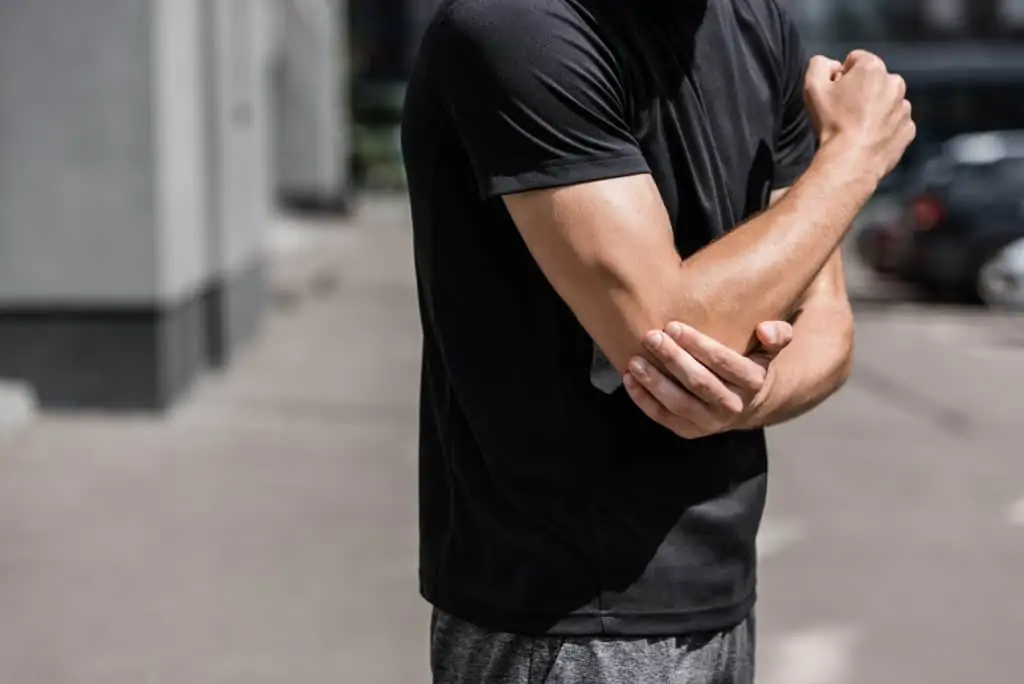
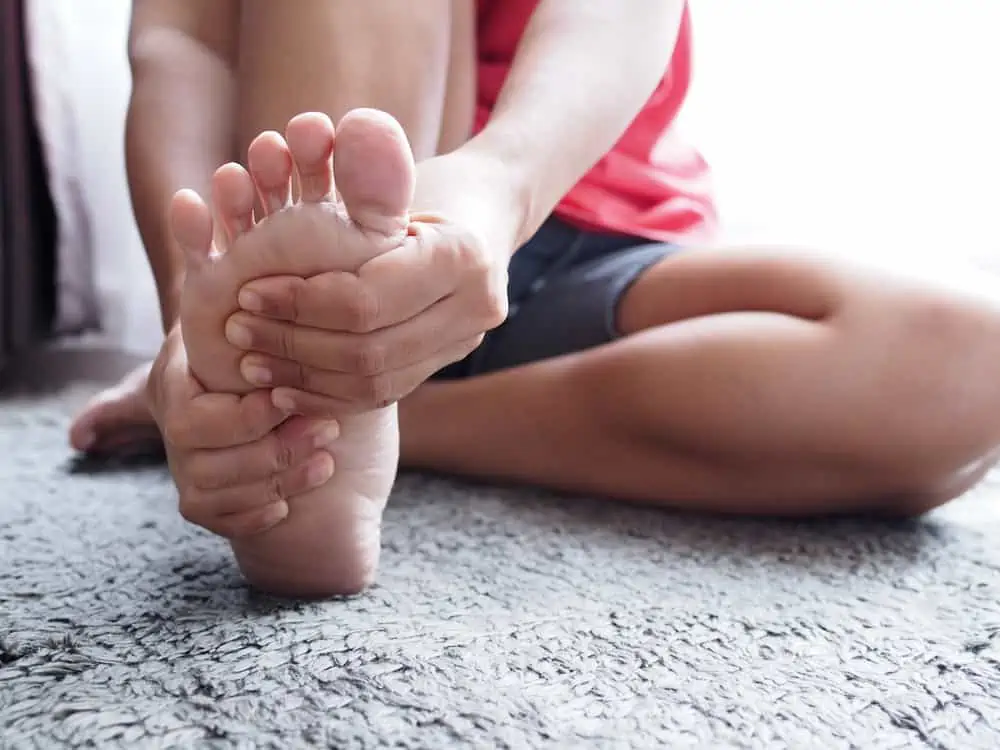
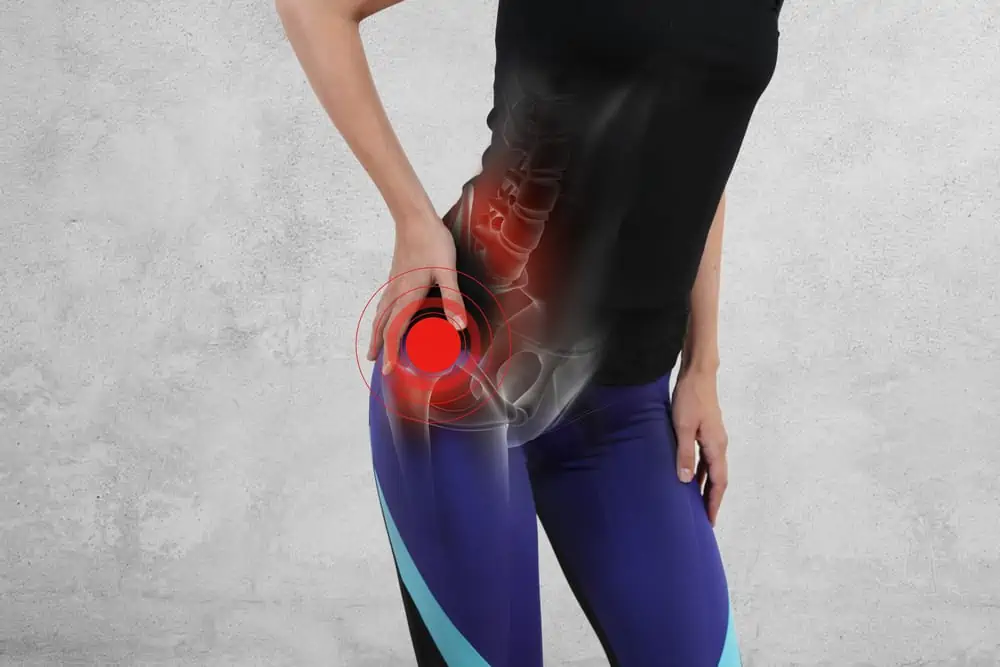
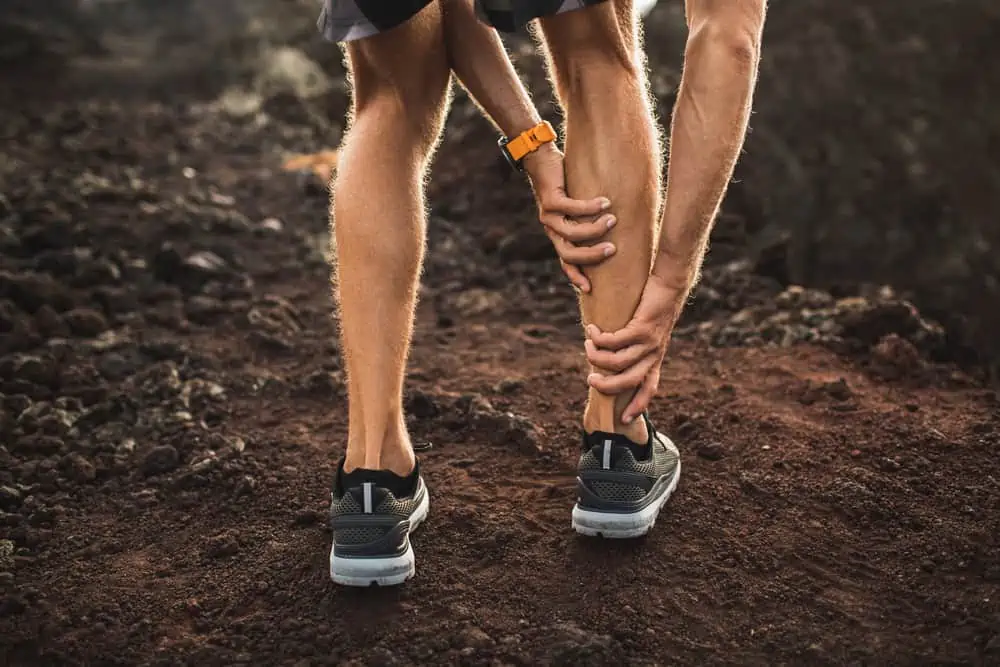
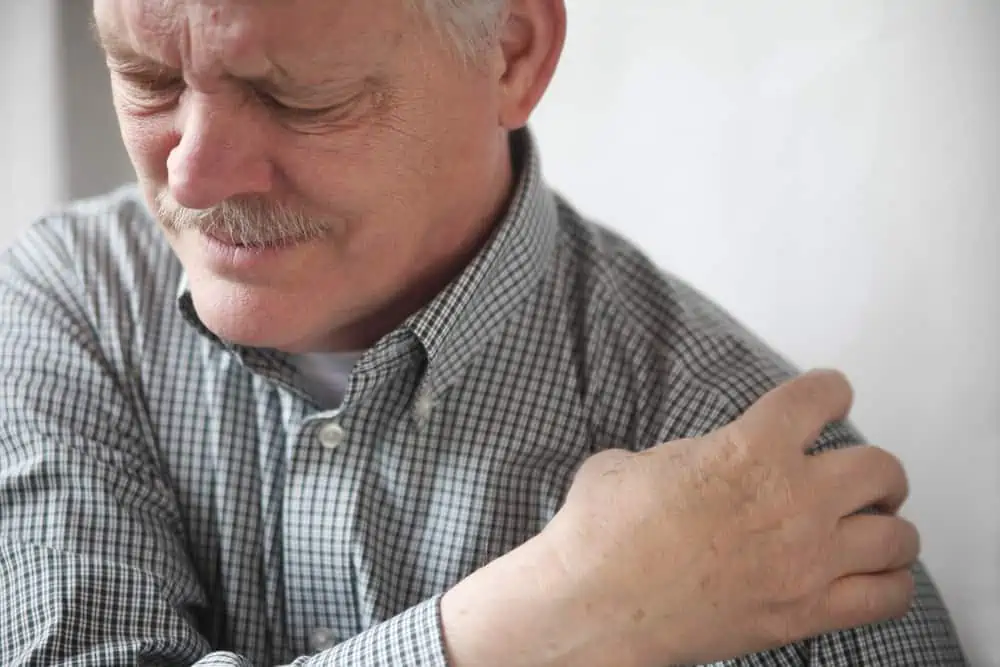


Very thorough article on tennis elbow. My husband had golfer’s elbow…like you said, similar, but different location. Some of these things helped him too.
Thank you, Patricia!
I’m glad I found this article because I have tennis elbow and I’m a writer. So, obviously that combination doesn’t go well together. I actually got it from scrolling with my mouse and typing. I see a chiropractor weekly and it has helped tremendously as well as icing occasionally. Thanks for the great information!
I’m so glad! Thank you for reading. Feel better!